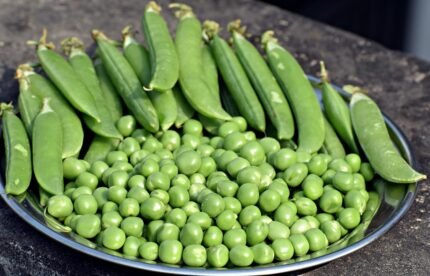Medically reviewed by Dr. Ramesh Gaddam, M.D. — Written by Sumalatha, D.N.H.E
Green peas are small, spherical seeds that are green in color and commonly used as a vegetable.
They belong to the legume family and are a rich source of nutrients, full of vitamins and minerals that can help keep you healthy.
They can lower cholesterol and support heart health. They also contain fiber, which is great for digestion.
Plus, green peas provide energy and can help you manage your weight. Adding green peas to your meals is an easy way to make your diet healthier.
1. Green Peas (Matar) Nutrition
Nutritional breakdown of green peas (per 100 grams):
| Nutrient | Amount per 100g |
|---|---|
| Calories | 81 |
| Water | 79% |
| Protein | 5 g |
| Carbohydrates | 14.5 g |
| Sugars | 5.7 g |
| Dietary Fiber | 5.1 g |
| Fat | 0.4 g |
| Vitamin C | 40 mg |
| Vitamin K | 24.8 µg |
| Vitamin A | 765 IU |
| Thiamine (B1) | 0.3 mg |
| Riboflavin (B2) | 0.1 mg |
| Niacin (B3) | 2.1 mg |
| Vitamin B6 | 0.2 mg |
| Folate (B9) | 65 µg |
| Iron | 1.5 mg |
| Magnesium | 33 mg |
| Phosphorus | 108 mg |
| Potassium | 244 mg |
| Zinc | 1.2 mg |
| Copper | 0.2 mg |
| Manganese | 0.3 mg |
2. Green Peas (Matar) Health Benefits
1. Rich Source of Nutrients
Green peas are full of important nutrients that help our bodies stay healthy.
They have vitamins like vitamin C, which helps keep our immune system strong, and vitamin K, which is good for our blood.
Green peas also contain minerals like iron and magnesium, which help give us energy.
Plus, the fiber in them helps with digestion and makes you feel full.
2. High in Antioxidants
Green peas are rich in antioxidants, which protect our bodies from damage.
These antioxidants help reduce stress in our cells and can lower the risk of getting sick.
Eating green peas can help keep your body healthy and strong.
Adding them to your meals is an easy way to boost your health.
3. Supports Heart Health
Green peas contain nutrients that are good for your heart, like potassium and folate.
Potassium helps control blood pressure, while folate supports healthy blood flow.
Eating green peas regularly can help keep your heart healthy and reduce the risk of heart problems.
They are a tasty addition to any meal!
4. Aids Digestive Health
Green peas are high in fiber, which is great for digestion.
The fiber helps keep things moving in your digestive system and prevents constipation.
This means you can feel more comfortable and healthy.
Adding green peas to your diet can help support a happy gut.
5. May Help with Weight Management
The fiber and protein in green peas can help you feel full and satisfied after meals.
This can help you eat less and manage your weight.
Green peas are low in calories, making them a smart choice for a healthy diet.
Including them in your meals can help you reach your weight goals.
6. Helps Control Blood Sugar
The fiber in green peas can help keep blood sugar levels steady.
It slows down how fast sugar is absorbed into the body, which can help prevent sudden spikes.
This is especially important for people managing diabetes.
Adding green peas to your meals can be a smart choice for balanced blood sugar.
7. Boosts Immune Function
Green peas are a good source of vitamin C, which helps strengthen your immune system.
A strong immune system is important for fighting off colds and other illnesses.
Eating green peas can help keep you healthy and make it easier for your body to resist infections.
They are a tasty way to support your health!
8. Supports Bone Health
Green peas are good for your bones because they contain vitamin K, which helps keep bones strong.
This vitamin helps your body absorb calcium, which is important for bone health.
Eating green peas can support your bone strength and help prevent problems as you age.
Adding them to your meals is an easy way to support your bones.
9. Promotes Skin Health
The vitamins A and C in green peas are great for your skin.
Vitamin C helps your body produce collagen, which keeps skin firm and youthful.
Vitamin A supports skin repair and health.
Including green peas in your diet can help keep your skin looking healthy and glowing.
10. May Reduce Inflammation
Some parts of green peas may help reduce inflammation in the body.
Inflammation can lead to various health problems, so keeping it in check is important.
Eating green peas regularly can help support your body’s ability to manage inflammation.
This can lead to better overall health and comfort.
3. Uses of Green Peas (Matar)
1. Cooking and Baking
Green peas can be cooked in various ways, including boiling, steaming, and sautéing.
They are often added to soups, stews, and casseroles for extra flavor and nutrition.
You can also use them in baking savory dishes like pies or quiches.
2. Salads
Fresh or thawed green peas can be a crunchy and sweet addition to salads.
They pair well with greens, other vegetables, and dressings, adding color and nutrition to your meal.
3. Side Dishes
Green peas make a great side dish on their own. Simply season them with a little butter, salt, and pepper, or mix them with herbs for added flavor.
They can be served alongside meats, fish, or grains.
4. Pasta Dishes
Adding green peas to pasta dishes is a delicious way to boost nutrition.
They can be mixed into creamy sauces, tossed with olive oil and garlic, or added to stir-fries.
5. Purees and Dips
Green peas can be blended into smooth purees or dips.
A pea puree can be used as a spread on bread or crackers, while a pea dip can be served with vegetables for a healthy snack.
6. Frozen Snacks
Frozen green peas are convenient and can be eaten straight from the bag as a healthy snack.
They are a low-calorie option that’s high in nutrients.
7. Baby Food
Green peas can be cooked and mashed or pureed for baby food.
They are a nutritious first food for infants, providing essential vitamins and minerals.
8. Smoothies
Adding green peas to smoothies is a unique way to boost nutrition without changing the flavor too much.
They add fiber and protein, making the smoothie more filling.
9. Vegetable Mixes
Green peas are often included in vegetable mixes, both frozen and fresh.
They add sweetness and texture to mixed vegetable dishes.
10. Canned and Dried Peas
Canned and dried green peas are available for those who want convenience.
Canned peas can be used in salads and soups, while dried peas can be cooked for soups or purees.
4. Green Peas (Matar) side effects
May Cause Gas and Bloating
Green peas have some sugars that can be hard for some people to digest.
This can cause gas and bloating, especially for those with sensitive stomachs.
If you notice discomfort after eating peas, try eating smaller amounts at first.
Allergies
While it’s not common, some people can be allergic to green peas. Symptoms may include itching, rashes, or even serious reactions.
If you know you’re allergic to legumes, it’s best to stay away from green peas.
Risk for Gout Patients
Green peas contain purines, which can turn into uric acid in the body.
For people with gout, high levels of uric acid can lead to painful flare-ups.
If you have gout, you might need to limit how many green peas you eat.
Kidney Stones
Green peas have oxalates, which can contribute to kidney stones in some people.
If you’ve had kidney stones before, it’s wise to be careful with foods that contain oxalates.
Moderation is key for keeping your kidneys healthy.
Phytic Acid
Green peas contain phytic acid, which can prevent the body from absorbing some minerals.
This usually isn’t a problem for most people, but those with low mineral levels might want to be careful.
Eating a balanced diet can help ensure you get the nutrients you need.
Carbohydrate Content
Green peas have carbohydrates, including sugars.
Although their fiber helps balance blood sugar, people with diabetes should pay attention to their overall carb intake.
Monitoring blood sugar levels is important for managing diabetes.
Blood Thinners
Green peas have vitamin K, which helps with blood clotting.
If you take blood-thinning medications, it’s important to keep your vitamin K intake steady.
Always talk to your doctor about how many peas are safe for you to eat.
Pesticide Residues
Non-organic green peas may have pesticide residues on them.
If you are worried about pesticides, you might want to choose organic peas instead.
This can help reduce your exposure to harmful chemicals.
5. Green Peas Protein
10. Green Peas Benefits for Skin
Green peas offer several benefits for the skin. They are rich in vitamins A and C, which help keep the skin healthy and glowing.
Vitamin C also supports collagen production, which is important for skin elasticity and firmness.
The antioxidants in green peas help protect the skin from damage caused by free radicals, which can lead to early signs of aging.
Additionally, the fiber in green peas aids in digestion, helping to clear toxins from the body that can affect the skin’s appearance.
Including green peas in your diet can help promote a clearer and more radiant complexion, making them a great choice for healthy skin.
11. Green Peas for weight loss
Green peas can be a helpful food for weight loss. They are low in calories but high in fiber and protein, which can keep you feeling full for longer.
This can help reduce hunger and prevent overeating.
Adding green peas to your meals can make dishes more filling without adding too many calories.
They can be easily mixed into salads, soups, or stir-fries.
Because they provide important nutrients, like vitamins and minerals, green peas can support your overall health while you lose weight.
Enjoying green peas as part of a balanced diet can be a tasty way to help reach your weight loss goals!
Medically reviewed by Dr. Ramesh Gaddam, M.D.

General Physician, Diabetologist, and Critical Care Specialist.
Discover more from Health Build-Up
Subscribe to get the latest posts sent to your email.




3 thoughts on “Green Peas: Health Benefits, Nutrition, Uses & Side Effects”
Comments are closed.